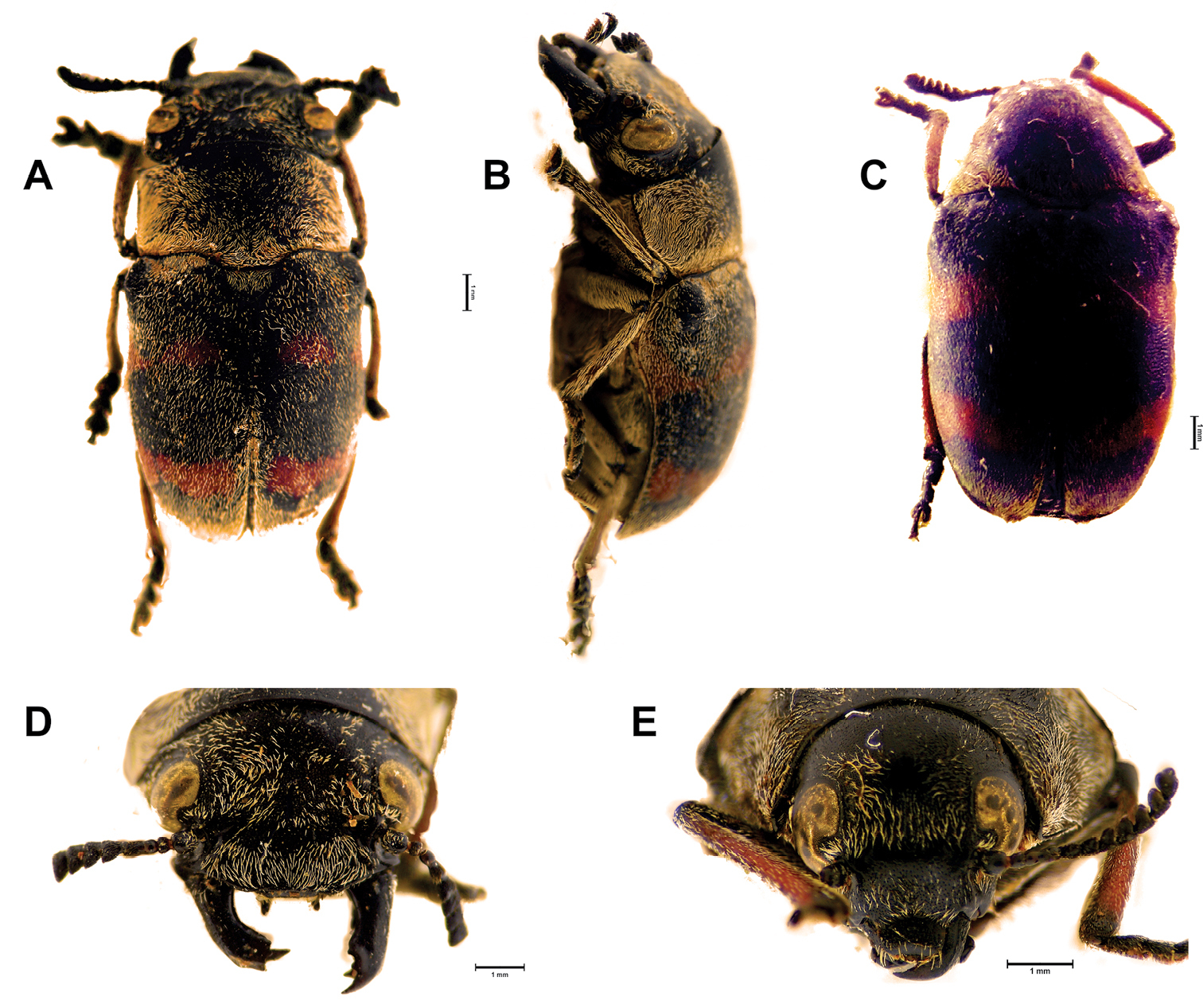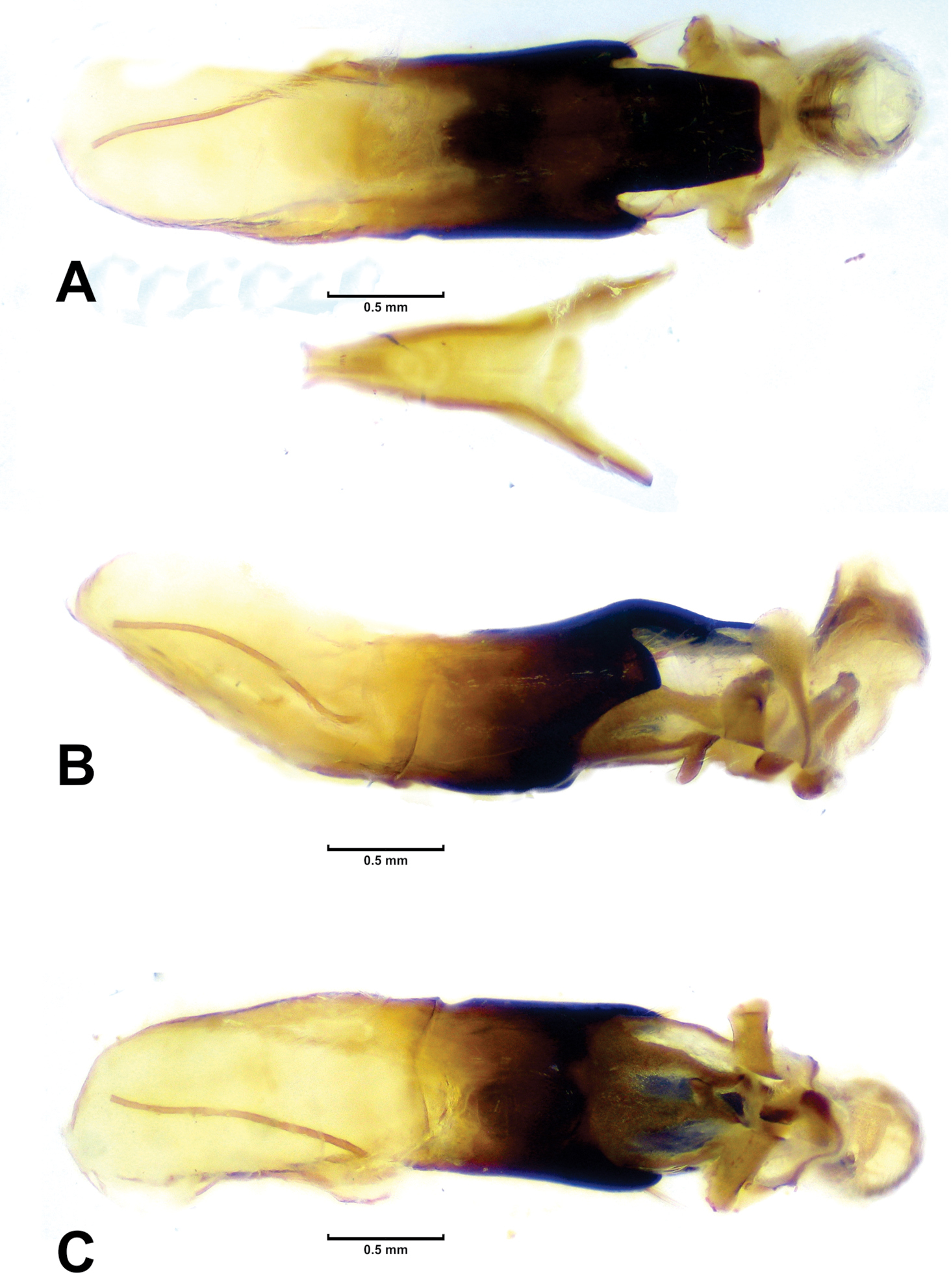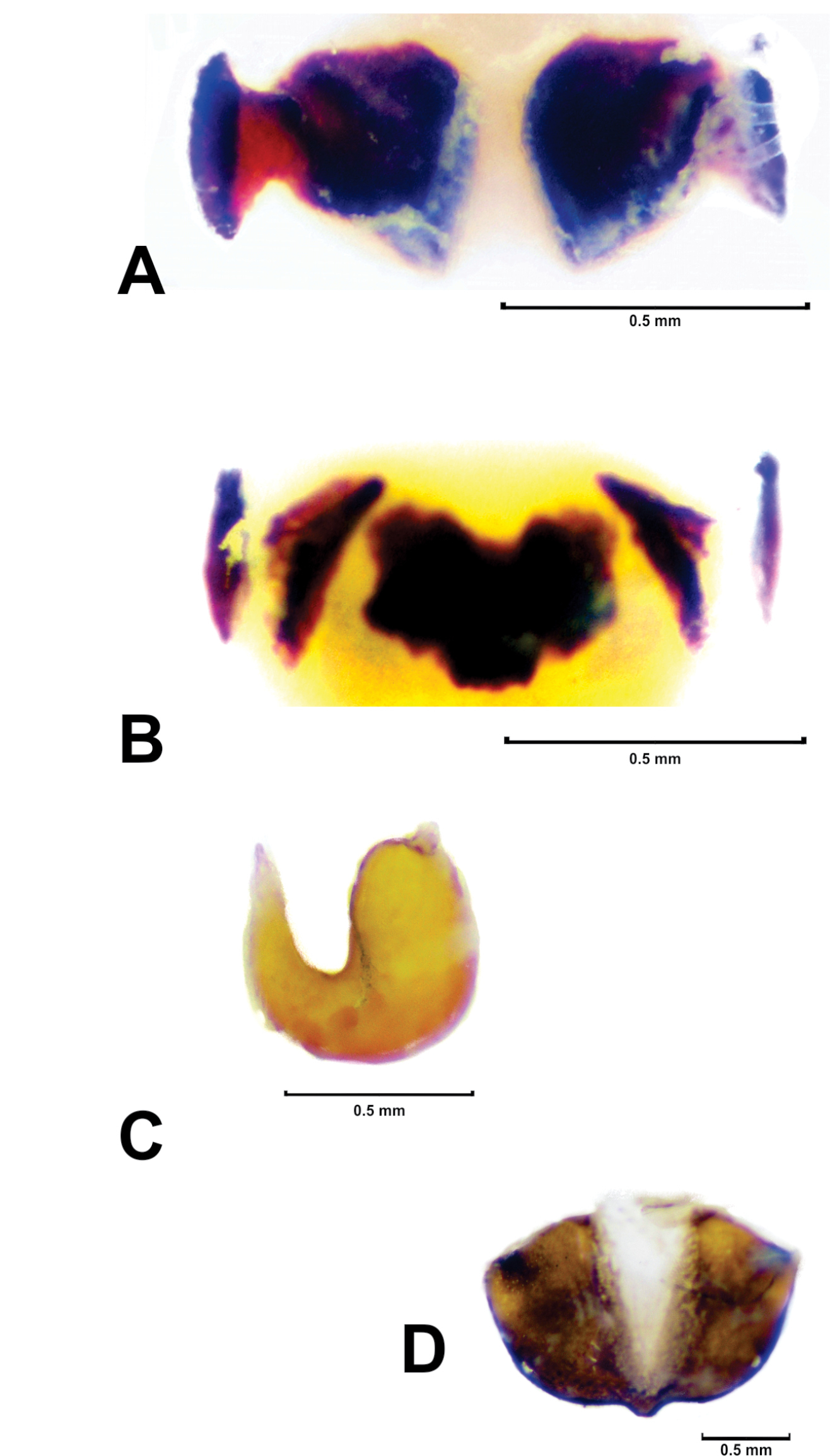






Citation: Agrain FA (2014) An interactive multi-entry key to the species of Megalostomis Chevrolat, with description of a new species from Paraguay (Chrysomelidae, Cryptocephalinae). ZooKeys 425: 59–69. doi: 10.3897/zookeys.425.7631
The main goal of this contribution is to release an interactive multi-entry key to all known species of the genus Megalostomis Chevrolat. This key constitutes a new tool created to aid the identification of the species of this diverse genus, which occasionally may be difficult to identify to the species-level, due to the lack of reference collections for most countries within its distribution range, and to the presence of intra-specific variation and secondary sexual characters. It is expected that this on-line key will facilitate future periodic updates, and will benefit all those persons interested in identifying these taxa. The present paper also includes the description of Megalostomis juanenrique sp. n., a new species from Paraguay. In addition, Megalostomis gigas Lacordaire, and Megalostomis robustipes Monrós are newly cited for the fauna of Paraguay. The online interactive Lucid key is available at http://keys.lucidcentral.org/keys/v3/megalostomis. Offline Lucid data files in LIF and SDD formats are also available at doi: 10.3897/zookeys.425.7631.app1 and doi: 10.3897/zookeys.425.7631.app2.
Lucid interactive key, Clytrini, Megalostomina, new species, new records
South America harbors a high diversity of Clytrini. Megalostomis Chevrolat, 1836 is the largest genus within the Neotropical subtribe Megalostomina, its species are phytophagous in the adult stage, primarily leaf and flower feeders. As larvae, they are case-bearers, some species are known to live in ant nests (
The material examined during this work came from Agr. Eng. Juan Enrique Barriga-Tuñon’s personal Collection (JEBC).
IADIZA Instituto Argentino de Investigaciones de las Zonas Áridas, Mendoza, Argentina.
INBP Museo Nacional de la Historia Natural del Paraguay, San Lorenzo, Paraguay.
JEBC Juan E. Barriga T. Collection, Curicó, Chile.
MACN Museo Argentina de Ciencias Naturales, Buenos Aires, Argentina.
Specimens were soaked in NH3 for ten minutes to relax their anatomical structures. To study the male genitalia, the aedeagus was removed through the pygidium and cleared in 10% hot KOH for five minutes (for the female the whole abdomen was removed). After the KOH clearing process, the aedeagus was washed in 80% ethanol and then glycerin was injected through the basal foramen, using a needle and the help of curved dissecting forceps, in order to evert the internal sac. Upon completion of the examination, the genitalia and other dissected parts were placed in a plastic microvial with glycerin, and pinned directly beneath each specimen.
All photographs were taken by the author. The source photos were taken at multiple focal planes (at least five) and then combined into a single image (with all features in focus) with the free software CombineZP (http://www.hadleyweb.pwp.blueyonder.co.uk/CZP/News.htm). Images for this study were taken with a Canon PowerShot S50 digital camera, mounted on a Leica S6E stereomicroscope. For the matrix-based key, all illustrations of characters and their states were taken from
The multi-entry interactive key was created by exporting the nexus data matrix used in
Megalostomis is easily diagnosable from Cryptocephalinae by the following characters: body length 6–14 mm, width 4–10 mm; prothorax without lateral antennal grooves; tarsal claws simple; prosternum evident between procoxae; procoxae globose; eyes strongly emarginate; and dorsal plate of aedeagus with straight margin. The latter two characteristics were found to be synapomorphies for the genus according to
PARAGUAY, San Pedro: Cororō (23.439011°S, 56.501807°W).
Holotype: male, pinned. Original labels: “White label (handwritten): Paraguay-San Pe /dro-Córoro/ M. Viana XI_1983_, Blue label (printed): ex Coleccion/ M. VIANA/ ARG 006244, White label (printed): Coleccion / J. E. BARRIGA / CHILE 067786”. Red label (printed): Megalostomis juanenrique sp. n. / Holotype/ Des. Agrain F. A. 2014. IADIZA. Allotype: female, pinned, with genitalia in a separate microvial. Original labels: “White label (handwritten): Paraguay.S.P./ Córoro/ M. Viana 1979, Blue label (printed): ex Coleccion/ M. VIANA/ ARG 006337, White label (printed): Coleccion / J. E. BARRIGA / CHILE 067005”. Red label (printed): Megalostomis juanenrique sp. n. / Allotype/ Des. Agrain F. A. 2014. IADIZA. Paratype: male, pinned, with genitalia in a separate microvial. Original labels: “White label (printed): PARAGUAY/ Córoro/ dic 1983/ leg. M. Viana, White label (printed): Coleccion / J. E. BARRIGA / CHILE 138773”. INBP. Paratype: male, pinned. Original labels: “White label (handwritten): Paraguay-S P/ Córoro/ M. Viana _1976, Blue label (printed): ex Coleccion/ M. VIANA/ ARG 006362, White label (printed): Coleccion / J. E. BARRIGA / CHILE 063063”. MACN. Paratype: male, pinned. Original labels: “White label (handwritten): Paraguay-San/ Pedro-Córoro/ XI_1985_ M. Viana, Blue label (printed): ex Coleccion/ M. VIANA/ ARG 006238, White label (printed): Coleccion / J. E. BARRIGA / CHILE 069889”. JEBC. Paratype: male, pinned, with genitalia in a separate microvial. Original labels: “White label (handwritten): Paraguay. S.P./ Córoro/ M. Viana 1976, Blue label (printed): ex Coleccion/ M. VIANA/ ARG 006406, White label (printed): Coleccion / J. E. BARRIGA / CHILE 067050”. JEBC. Paratype: male, pinned, with genitalia in a separate microvial. Original labels: “White label (handwritten): Paraguay. S.P./ Córoro/ M. Viana 1976, Blue label (printed): ex Coleccion/ M. VIANA/ ARG 006270, White label (printed): Coleccion / J. E. BARRIGA / CHILE 057918”. JEBC. All paratypes with my label: Red label (printed): Megalostomis juanenrique sp. n./ Paratype/ Des. Agrain F. A. 2014.
This new species belongs to the Megalostomis grossa species group as defined by
11.3–12.5 mm, width: 6.3–7.2 mm.
(Figs 1A–B, D, 2). Coloration pattern: elytra reddish, with three interspaced sub-transverse black bands, all reaching lateral margin of elytra, basal band reaching humeral carina, and apical band reaching elytral apex. Head: anterior surface smooth, with central protuberance at upper region of clypeus, mostly glabrous with disperse pubescence; inter-ocular space with thin longitudinal carina, with a pair of slightly depressed sub-adjacent areas on either side; internal margin of eyes with strongly marked carina, posterior side of eye with salient post-ocular protuberance, next to a marked furrow. Mandibles asymmetric; apex of mandibles with a series of peaks (molariform area) surrounding a depressed area that fits into the right mandible; right mandible curved inward, mandibular apex with a very sharp tooth on its underside; left mandible straight, with sharp bifurcated teeth; with common intra-specific variation in size among examined series. Clypeal margin, straight, without auricular appendix. Antennae: as long as pronotum, black; scape robust; serrate beyond fourth antennomere, eleventh antennomere with two marginal excavations that delimit central lobe. Thorax: pronotal disc: longer than high, sub-rectangular, lateral margins visible from above; posterior projection short; median lateral region with slight transverse constriction; punctation weak and regular; pronotal disc pilosity limited to its margins; scutellum wider than long, with posterior margins curved, covered with white dense pubescence. Elytra: apical margin projected, surpassing pygidium; elytral humeral region wider than pronotal base, gradually narrowing toward apex; diffuse punctation, denser than that of pronotum; elytral margin narrow, enlarged in humeral region; humeral carina rounded, apex with transverse mark. Genitalia: (Fig. 2A–C) apex of dorsal plate of median lobe as wide as its base, with anterior margin straight; lateral arms of median lobe short, with setae; dorsal sclerite of internal sac (not everted) upward-directed, forming a wing-shaped structure in dorsal view; ejaculatory guide with ventral keel; sperm transfer structure with campanulate sclerite.
Megalostomis juanenrique sp. n. A Habitus dorsal (male) B Habitus lateral (male) C Habitus dorsal (female) D Head of male (frontal view) E Head of female (frontal view).
Megalostomis juanenrique sp. n. A–C Male aedeagus and internal sac: A Dorsal view B Lateral view C Ventral view.
(Figs 1C, E, 3). Coloration pattern: same as male. Head: smaller than that of male; mandibles compact and short. Antennae: same as male, but shorter than pronotum (with smaller antennomeres). Thorax: pronotum with sides slightly more curved than in male. Abdomen: sternites same as in male, fifth sternite excavate. Pygidium: with apical excavation and, apical transverse depressed area. Rectal sclerites: dorsal rectal sclerites (Fig. 3A) represented only by dorsal (subquadrate) apodemes, and central dorsal plate. Central dorsal plate (Fig. 3B) subquadrangular with three arms; ventral rectal sclerites with very short apodemes. Spermathecal capsule: (Fig. 3C) U-shaped, distal part more than 2× longer than proximal part, proximal part longer than base; angle formed between basal and apical regions of spermathecal capsule less than 45°; apex of spermathecal capsule long, with sharp tip. Eighth sternite with central tooth (Fig. 3D).
Megalostomis juanenrique sp. n. A Kotpresse ventral sclerite B Kotpresse central dorsal plate and dorsal apodemes C Spermathecal capsule D Sternite VIII.
Specific name is treated as a noun in apposition (
Megalostomis gigas Lacordaire
One specimen from: PARAGUAY, San Pedro: Cororō (23.439011°S, 56.501807°W). February 1979, Leg. J. M. Viana. JEBC.
Megalostomis robustipes Monrós
One specimen from: PARAGUAY, Dep. Cordillera: Pirareta, (25.483333°S, 56.933333°W). 26–31 August, 2011. Leg. U. Drechsel. IADIZA.
The main benefit of the interactive multi-entry key is that the user needs to follow fewer options compared with traditional dichotomous keys, and these options can be freely chosen; this generally leads to more effective identification. More important, both experienced and inexperienced users are more likely to succeed when identifying problematic species (
I would like to thank Nelly Horak for useful advice on the English language, and Ulf Drechsel for providing me with distributional data for Megalostomis robustipes. I also want to thank Juan Enrique Barriga-Tuñon and his wife Maria Isabel Miranda Rivadeneira, for their generous invitation and warm welcome in their beautiful house, vineyards, and fabulous insect collection. I also thank two anonymous reviewers for their generous and helpful comments. Continued research support is provided by CONICET. Partial support for completion of this work was provided by ANPCyT (Agencia Nacional de Promoción Científica y Técnica, Argentina) PICT#2011-2573, and PIP#112-200801-01869, CONICET).
Key to the species of Megalostomis v.1.0, LIF3 file
Federico A. Agrain
Data type: Lucid Interchange Format version 3 (LIF3), file: Key to the species of Megalostomis v.1.0.
Explanation note: This XML-based format allows exchange of the key with other key developers.
Copyright notice: This dataset is made available under the Open Database License (http://opendatacommons.org/licenses/odbl/1.0/). The Open Database License (ODbL) is a license agreement intended to allow users to freely share, modify, and use this Dataset while maintaining this same freedom for others, provided that the original source and author(s) are credited.
Key to the species of Megalostomis v.1.0, SDD file
Federico A. Agrain
Data type: Lucid SDD file: Key to the species of Megalostomis v.1.0.
Explanation note: This is a XML-based file structured using the internationally agreed SDD (Structure of Descriptive Data) Schema. This SDD file may be used to exchange the Lucid key with other SDD-compliant applications.
Copyright notice: This dataset is made available under the Open Database License (http://opendatacommons.org/licenses/odbl/1.0/). The Open Database License (ODbL) is a license agreement intended to allow users to freely share, modify, and use this Dataset while maintaining this same freedom for others, provided that the original source and author(s) are credited.


